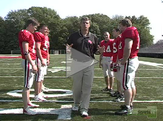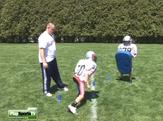PlaySportsTV Football
Coaching Youth Football: Don’t Stop Teaching Fundamentals

Don't Stop Teaching Youth Football Fundamentals
By Marty Gitlin
Special to PlaySportsTV
Larry Pinto has seen it before and it makes him cringe.
The highly successful football coach at Mayfield High School in Cleveland believes many youth football coaches stop teaching fundamentals too early.
(Instruct the best coaching techniques through PlaySportsTV training plans. Shedding Blocks is one of over 120 videos in the Football Drills & Tips Video Library.)
Pinto thinks football fundamentals should remain a staple of practices for quite a while so young players will learn how to play football the right way. But he’s watched as coaches have scrapped pointing out the basics in favor of starting scrimmages that their players are simply not prepared to play.
“A lot of coaches, maybe three or four weeks into teaching beginners will go into scrimmage situations,” Pinto said. “But you have to stick with the blocking and the tackling and how to throw and ball and how to catch the ball. You need to work on pursuit angle drills for different positions.”
That, Pinto admits, leads to another problem. Learning football fundamentals is essential, but it also can prove rather dull. So, Pinto says, it’s up to youth football coaches to make the sport fun enough for the kids to want to continue participating.
Pinto is pleased that young players in his community want to keep playing football on the high school level. The kids who enjoy playing are most likely to properly learn both the fundamental and more intricate aspects of football.
“The most important thing for coaches is that they have to be cheerleaders during practice all the time,” Pinto says. “You have to try to be as positive as you can. And you have to be creative with every kid involved in a circuit. Every kid should get the experience of playing a lot of different positions and should remain active throughout practice. That way they’re kept interested while they’re working on fundamentals.”
Pinto adds youth football coaches are responsible for encouraging interested players in taking their talents to the middle school and high school levels. It is up to the coaches to determine the most appropriate positions for each and eventually have them concentrate on those spots on the field so they are ready to make steady contributions to their school teams. Of course, the varied growth patterns of youth eventually change some players’ positions.
“Youth coaches must continue to evaluate what they have,” Pinto says. “Sometimes the coach is a father of one or more of the players, but you need him to be as unbiased as possible. When we run youth clinics, we go around to all the positions and evaluate things like how each kid throws the ball or catches the ball or how fast they can run the 40-yard dash. Then our ninth-grade coach is given a scouting report on every kid.
“Once kids get into high school, they’ve generally had their big maturing years, which usually comes in seventh and eighth grade,” Pinto said. “Some kids develop late. They don’t grow into their bodies until 10th or 11th grade. But youth coaches can get the majority of kids into the right positions. To me, that’s coaching. Everyone has the X’s and O’s, but putting kids into the right positions? That’s coaching."
###
Learn the best coaching techniques through PlaySportsTV football training plans.
Story courtesy of Red Line Editorial, Inc.






